![]() Courtesy of Tom Steiner-Threlkeld
Courtesy of Tom Steiner-Threlkeld
Nasdaq OMX Group said it expects the re-launch of its PSX exchange as an exchange-traded fund marketplace to take place in May.
Final approval of the refashioning the “price size exchange” as a “price time” exchange focused on exchange-traded products must come from the Securities and Exchange Commission.
The exchange operator hopes to encourage trading in a wider variety of ETPs by created two types of market participants — Registered Market Maker and PSX Supplemental Liquidity Providers — which will take ”affirmative quoting” obligations.
PSX also intends to create competition among market makers, by offering the largest rebate to a Lead Market Maker. Other registered market makers can compete for that designation and while making markets in ETPs receive rebates, at a lower level.
Rebates to liquidity providers can be as high as $.0028 per added share, according to a PSX pricing page. Fees to remove liquidity start at $0.0030 per .
”PSX is a key piece of our larger strategy to better service the ETP industry with a platform designed to incent high-quality liquidity, market incentive programs and ETP-specific functionality.” said Eric Noll, Executive Vice President of Transaction Services U.S. and U.K. at Nasdaq OMX, in a statement Monday.
The relaunch of PSX will create a second market that is focused on ETPs. NYSE Euronext’s Arca exchange currently operates as an ETF-focused exchange. NYSE Arca has both the largest market share in exchange-traded trading among national exchanges and 93 percent of ETP listings.
The move comes roughly 2 1/2 years after PSX was created as a Price Size Exchange that would give priority to the size of an order over the speed of arrival.
Nasdaq OMX CEO Robert Greifeld at the time called this the “most fundamental change in market structure” since the launch of the all-electronic Nasdaq Stock Market itself in 1971.
But the idea that “size matters’’ never took hold. In February, PSX accounted for three-fourths of one percent of total equities trading in the United States. For the entire story from TradersMagazine, please click here











